David Dinkins was a New York City mayor, and a tennis superfan
By Steve Tignor Nov 24, 2020Betting Central
Line Calls, presented by FanDuel Sportsbook: ATP Mutua Madrid Open Betting Preview
By Baseline Staff Apr 24, 2024Madrid, Spain
Despite jet lag, Sloane Stephens keeps winning in Madrid with big goals for clay swing
By David Kane Apr 24, 2024Social
It's a girl! Belinda Bencic welcomes her first child, a daughter named Bella
By Baseline Staff Apr 24, 2024Madrid, Spain
Naomi Osaka victorious in Madrid return, defeats Greet Minnen for first clay win since 2022
By David Kane Apr 24, 2024Brian Tobin, former president of the International Tennis Federation, dies at age 93
By Associated Press Apr 24, 2024Madrid, Spain
Elena Rybakina is a sore winner (this is a good thing)
By Peter Bodo Apr 23, 2024Zendaya, Josh O'Connor and Mike Faist on the steamy love triangle of 'Challengers'
By Associated Press Apr 23, 2024Madrid, Spain
Tatjana Maria will follow daughter Charlotte’s first tournament on live scores from Madrid
By David Kane Apr 23, 2024Madrid, Spain
“I hope to make it”: Carlos Alcaraz eyes Madrid three-peat for 21st birthday gift
By TENNIS.com Apr 23, 2024David Dinkins was a New York City mayor, and a tennis superfan
Dinkins helped reroute jets that once roared out of LaGuardia airport during the US Open, but he may have been most proud of the many years he spent as a USTA board member, and what he was able to accomplish there.
Published Nov 24, 2020
Advertising
On Monday night, former New York City mayor and staunch tennis supporter David Dinkins died at 93. Besides his significant involvement with the US Open—he helped broker a 99-year lease of land in Queens between NYC and the USTA—he founded the David Dinkins Tennis Club at "The Jungle," a set of tennis courts off Harlem River Drive.
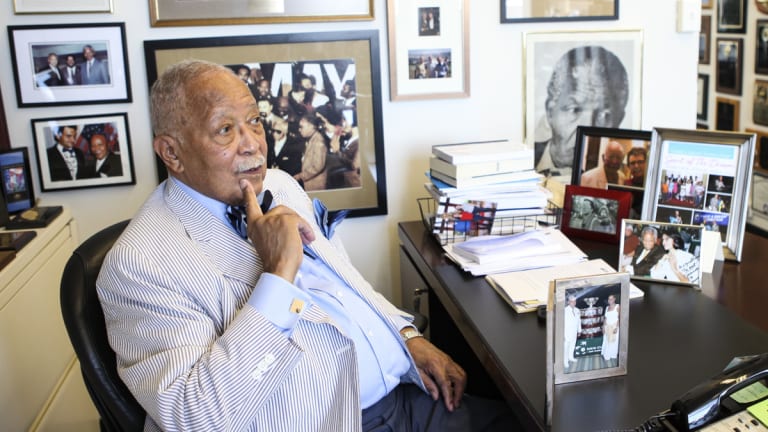
David Dinkins was a New York City mayor, and a tennis superfan
© anita aguilar
Advertising
All photos from Anita Aguilar
The courts, which are featured in the below story from 2015, enriched a community through tennis, and continue to leave a positive impact to this day—just as Dinkins' legacy will do for generations to come.
The sun has just begun to rise over the East River in New York City on a summer Saturday morning, but activity is already well underway inside the Frederick Johnson Playground.
Children, who can feel the humidity building on this July day, dash happily through the spray from a water fountain, while their parents watch from whatever precious piece of bench they can snag in the shade.
But there’s no sitting, and no slowing down, on the eight red-and-green tennis courts just behind them. In one corner, two men go at it hammer and tongs in an all-court battle; the sound of their sneakers scraping the asphalt surface carries through the air. On another court, a middle-aged man and woman pound ball after ball in rallies that seem to stretch for minutes. “Some people are afraid of the heat,” the man says with a scoffing laugh as he takes a cut at a forehand.
In another corner, though, preparations are still being made for play. That’s where Gerry Weekes pushes hard at a broom, sweeping away the last of the leaves and acorns that fall from the surrounding trees. “You want to play, you grab a broom,” Weekes says with a smile. This is the do-it-yourself maintenance ethos of the urban tennis warrior.
Weekes, a Vietnam veteran and member of the tennis team at Bronx Community College in the 1970s, is happy to point out both the blessings and drawbacks of the courts he now calls home five days a week. He shakes his head as he points to a net with a missing crank, and another that sags in the middle. But he brightens as he pushes his foot down and feels the court give way. When the facility was resurfaced a few years ago, a little bit of cushion was added to half of the courts.
“It’s good for the joints on us old-timers,” Weekes says with a smile.

David Dinkins was a New York City mayor, and a tennis superfan
Advertising
The courts at The Jungle (Photos by Anita Aguilar)
This is the affectionate nickname for the Frederick Johnson courts, which are tucked into a corner of northeast Manhattan across the river from Yankee Stadium. According to local lore, there was once a private tennis facility in the area and when it rained, its clay courts would stay wet longer than the ones in this park, so the members would say, “Let’s go down to the asphalt jungle.”
Half a century later, the spot still lives up to its billing. The playground is bounded by a busy thoroughfare, Adam Clayton Powell Jr. Boulevard, to the west, and an even busier thoroughfare, the Harlem River Drive, to the east. In between, though, you’ll find a tree-lined tennis oasis, where the sound of traffic gives way to the sound of racquets meeting balls. The complex got its official name in 1971, when it was dedicated to Johnson, a one-armed teaching pro who discovered a young girl named Althea Gibson roaming the streets of Harlem and put a tennis racquet in her hand.
More than half a century after that transformative moment, the sport is still played here from early morning until late at night. This is the rare New York City public facility with lights.
“There probably aren’t quite as many people playing here as there were way back,” Weekes says. As in the rest of the U.S., tennis had its heyday in Harlem in the days of Chrissie, Jimbo, Ashe and Johnny Mac. “In the ’70s, it was full all day, every day. But it’s still a good crowd out here now.”
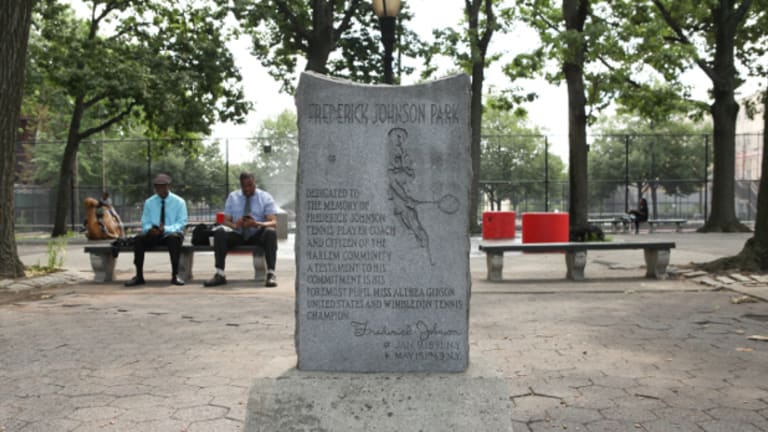
David Dinkins was a New York City mayor, and a tennis superfan
Advertising
The playground, which features eight tennis courts, are named after local hero Frederick Johnson, a one-armed teaching pro who gave Althea Gibson her first lesson in 1941 and nurtured a thriving tennis community in Harlem. (Anita Aguilar)
With higher temperatures in the forecast today, that crowd is out early. One of its regular members, Aubrey Smith, a business consultant, takes a break in the shade and explains the Jungle’s appeal.
“This place is the Mecca,” Smith says. “People come out here and play in the snow.”
Smith took up the game a few years ago after a friend died from a heart attack, motivating him to get in shape. But he fell in love with the sport for another reason. “Everything in New York is in your face,” Smith says. “Tennis is subtle, you need someone to bring you on. This place has its elder statesmen, guys who have been here forever who introduce you to the sport, tell you about the great Harlem players. They teach you that tennis is about learning how to comport yourself.”
“The game entices you here,” he adds. So far it has worked well for Smith, who says he has dropped from 250 pounds to about 200 since he picked up a racquet.
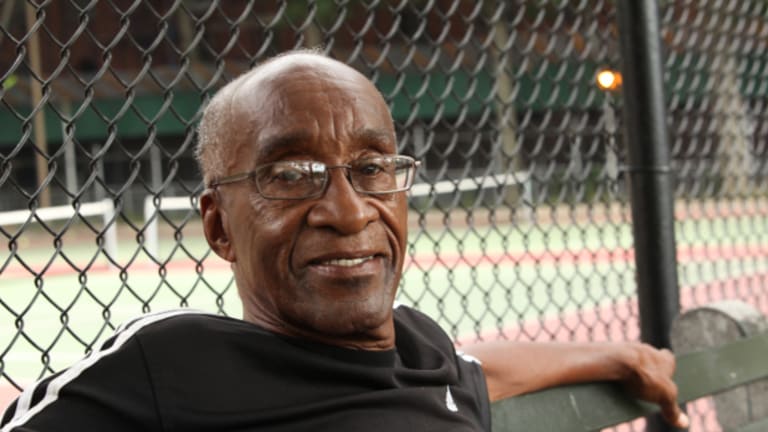
David Dinkins was a New York City mayor, and a tennis superfan
Advertising
For one of The Jungle’s elder statesmen, Reggie Satterfield, tennis is about maintaining his good health as he enters his 70s.
“I used to play 24/7, but now I just hit to stay in shape,” Satterfield says. A transplant to Harlem from Virginia who played on the tennis team at Howard University before going into banking, he claims his days of serious competition are behind him. “I don’t think I can play that modern game, hitting back and forth from the baseline. I miss the serve and volley, drop shots and lobs that we had in the past.”
Smith and Satterfield agree that a big part of what makes The Jungle special is its association with tennis’ past and present. Six years ago, another revered name in the African-American tennis community, David Dinkins, put his own stamp on these courts. With his friend and frequent tennis partner Sam Penceal, the former New York City mayor formed the David Dinkins Tennis Club at The Jungle. Courts were dedicated to legendary African-American tennis players, while Penceal and his wife, Bernadette, began a free family program on summer weekends.
“Family,” as anyone can see from watching Penceal run his Saturday morning clinic on these courts, is the operative word. He doesn’t just teach the neighborhood’s kids, he teaches their mothers and fathers as well. Penceal insists that parents participate in his program.
“The experience is more beneficial all around,” Penceal says. “I want to teach the parents to hit the ball to their kids. If tennis is an activity they can do together, they’ll stay with it longer. And I also want parents to learn to have appropriate expectations for how good their kids might be at a certain age. They should know this game isn’t easy.”
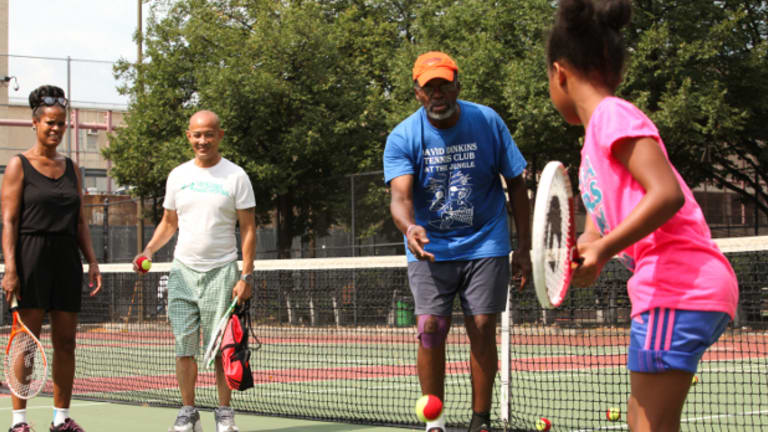
David Dinkins was a New York City mayor, and a tennis superfan
Advertising
So while Penceal, a charismatic former middle-school principal with a big and easy laugh, demonstrates to the children how to follow through on a forehand and sidestep across the baseline, it’s the children’s parents who serve as their hitting partners. Since Penceal and his wife launched the program, interest in it has only grown in the community.
“Families here need to have things they can do together,” Penceal says. “When children and parents get involved in tennis, it’s a magical experience.”
Grandparents, too. “It’s a beautiful thing, everyone comes together,” says Lawrence Cummings, a local resident whose daughter and 5-year-old grandson are regulars in Penceal’s program. “The parents develop their own skills, and the learning goes back and forth. It has planted a seed with our family; you can see their knowledge and ability grow each week.”
On this day, Penceal wears a blue T-shirt with Dinkins’ name emblazoned across the front. The two played together on courts around the city for decades, but in recent years the former mayor, who is now 88, has finally had to give up his four-day-a-week tennis habit. Still, sitting in his office at Columbia University, surrounded by a lifetime’s worth of tennis photos and memories, Dinkins remains proud of what he and Penceal have accomplished in Harlem, and what African-Americans have achieved in tennis since Gibson, another friend of his, integrated the game at Forest Hills in 1950.
“Sam had no backhand until he played me,” Dinkins jokes of their doubles matches, “but we hit every ball to his backhand, so he has a good one now.

David Dinkins was a New York City mayor, and a tennis superfan
© anita aguilar
Advertising
The late David Dinkins. (Anita Aguilar)
“I’ve been involved with The Jungle for many years,” Dinkins continues, recounting how he helped get lights installed there when he was Manhattan borough president in 1986. “A lot of great players have played in that space. Sydney Llewellyn, who was Althea’s husband, was the pro there, and when you beat someone on those courts, you used to brag, ‘I sent him to Sydney!’ But there was no one who was more fun to watch a match with than Sydney. You learned something on every point.”
Dinkins, who didn’t take his first lesson until he was nearly 40, got his start in tennis as what we would now call a super fan.
“There was a tournament at a black country club in New Jersey called Shady Rest each year,” Dinkins remembers, “and I would get a player’s badge and walk around and meet all the players. I was a big fan of Arthur [Ashe].”
It was in his role as a relentless booster for the game that Dinkins has had his biggest effect on tennis. Many fans who have been to the US Open since 1990 still thank the mayor for helping to reroute the jets that once roared out of LaGuardia airport and straight over Flushing Meadows. But Dinkins may be most proud of the many years he spent as a USTA board member, and what he was able to accomplish there.
“My greatest interest and concern was that people playing tennis look like this country,” Dinkins says. “I was there when we named the tennis center for Billie Jean [King]. It was my experience that merely being in the room and having a seat at the table alters things.”

David Dinkins was a New York City mayor, and a tennis superfan
© anita aguilar
Advertising
Dinkins at his desk, surrounded by photos of his time in tennis. (Anita Aguilar)
Along those lines, Dinkins is happy to see the USTA elect its first African-American president last year. He was even more pleased that the woman with a seat at that table is his friend Katrina Adams.
“She’s like my daughter,” says Dinkins, whose face brightens at the mention of Adams’ name. “I’m not surprised she is where she is now; she can do everything.”
Dinkins, who says his son, David Jr., “is even worse than me” when it comes to his tennis addiction, understands the value of making tennis a family affair, and understands how important Penceal’s program is in Harlem.
“Through tennis,” Dinkins says as he picks up a photo of Ashe and his daughter, Camera, “hundreds of thousands of youngsters become better people.”
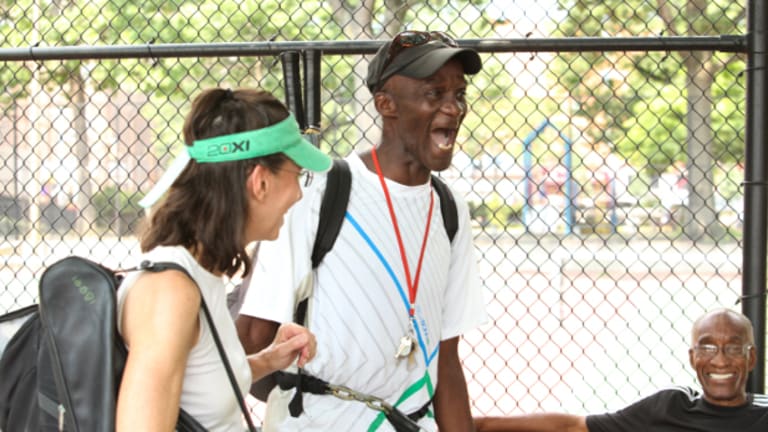
David Dinkins was a New York City mayor, and a tennis superfan
Advertising
It’s nearly noon at the The Jungle, and a few of those youngsters are on their way home, racquets in their hands and parents by their sides. Penceal, as he watches them go, sees progress.
“I started this because I felt that too many of our juniors weren’t getting good tennis instruction when they started,” says Penceal, whose program has received grant money from the USTA. “And that hampers them later. It was slow getting started, but now I hear kids say they can’t wait to get here on Saturday. I even hear parents say that, and that’s what we need.”
As the heat reaches the 90s, the action on the other courts at the Johnson Playground also begins to slow down. Making their exit are Weekes and his tennis partner for the day, Lisa Marroni. Once they had brushed the court clean, they enjoyed a long morning hit. Marroni is a lawyer who regularly travels north from her midtown Manhattan apartment to play with Weekes; when they’re done, he walks her to a nearby subway station.
“It’s that feeling when you hit a good shot,” Marroni says when describing what she loves most about tennis. “It’s a moment of timelessness.”
It’s a moment that tennis players everywhere understand. If you know the feeling, and if you love tennis—and if you can sweep a court and crank up a net now and then—you’re welcome in The Jungle.